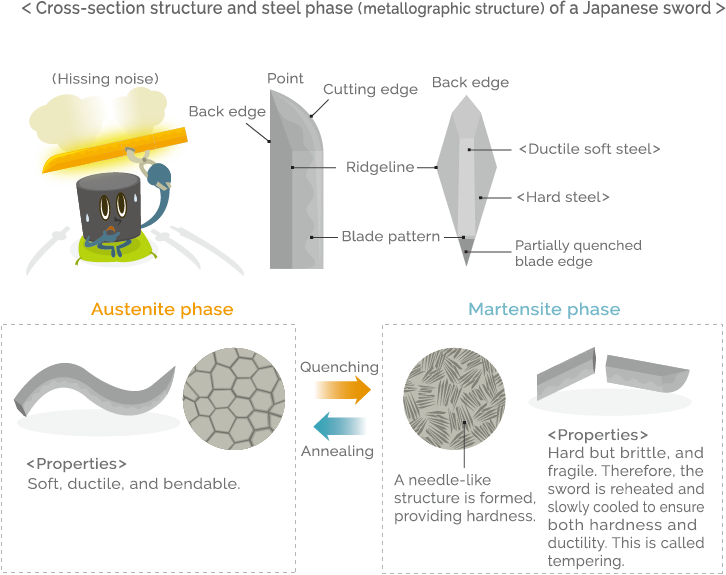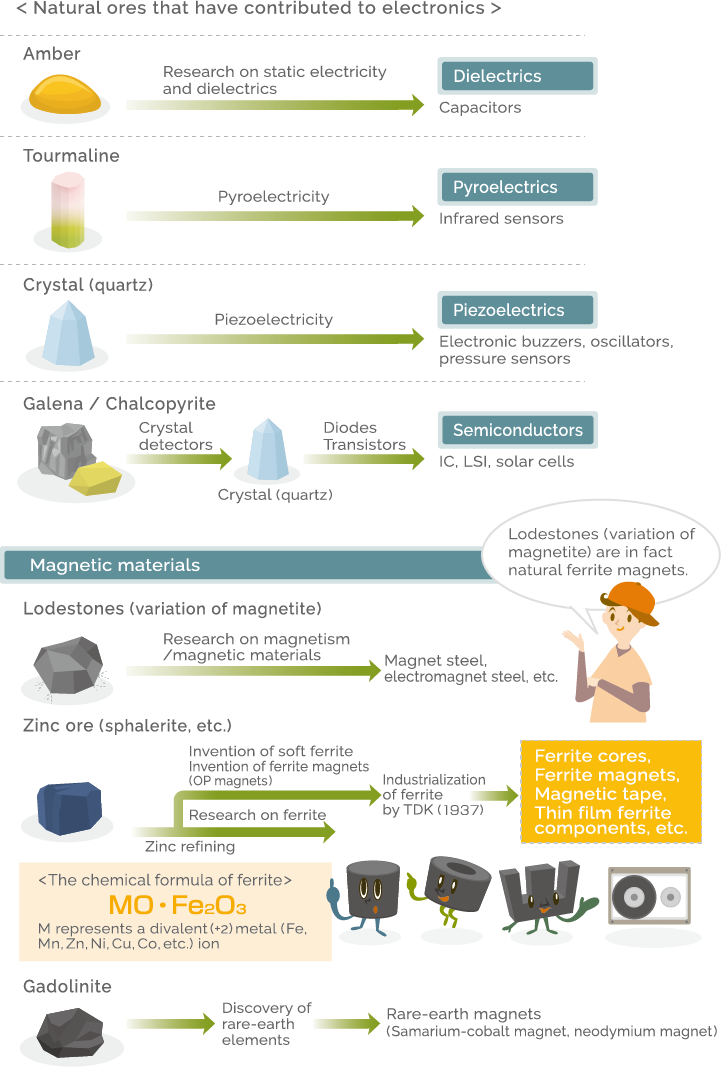Ferrite World
Vol. 1 Welcome to the ferrite world

Ferrite is a magnetic material that significantly contributes to the miniaturization, thinning, improved functionality, energy- and resource-saving, etc. of electric or electronic devices, including televisions (TVs), personal computers, mobile phones, HEVs (hybrid electric vehicles), and wind power generation. However, neither the profile nor the performance of ferrite is generally known despite its fundamental support for the modern electronic society and wide use in people’s lives. Ferrite is suitable to explore the interestingness and depth of magnetic materials. This reader-friendly article series describes the world of “Ferrite” which is the origin of TDK, without using complicated theories or formulas.
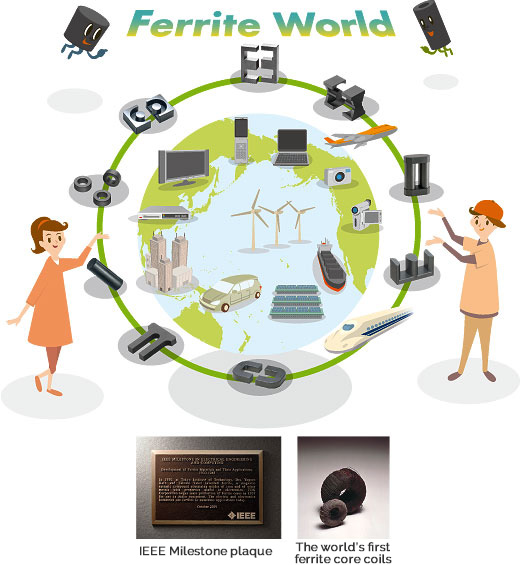
Ferrite is a magnetic material created and developed in Japan. It was recognized as the prestigious IEEE Milestone.
Every technology has its roots. In 1930, about 80 years ago, Dr. Yogoro Kato and Dr. Takeshi Takei at Tokyo Institute of Technology unexpectedly found strongly magnetic metal oxide consisting primarily of iron oxide during their research into improving a method for extracting zinc from zinc ores. This is how the OP (oxide powder) magnet, the world’s first ferrite magnet, was invented (it was the predecessor of the current ferrite magnets, and was made by shaping and baking magnetite and cobalt ferrite). They also invented ferrite that can be used as the core material of transformers (electric transformers), in addition to ferrite for permanent magnets, opening the door to the then-unknown ferrite world.
TDK was founded in 1935 with the aim of commercializing ferrite, Japan’s original invention (its initial name was Tokyo Denki Kagaku Kogyo K.K. TDK is an abbreviation for the name). It was exactly the time when high-frequency (high-frequency alternating current) technologies were at a developmental stage. TDK’s ferrite cores were used as antenna cores for wireless communication devices or radios, and about 5 million units were shipped until the end of the Second World War (1945). After the war, the applications of ferrite further expanded into cores for the cathode-ray tubes of TVs and transformers, the magnetic heads of tape recorders and video tape recorders, noise suppression components, etc. In recent years, ferrite has greatly contributed to energy and electricity saving involving battery voltage converters (DC-DC converters) for hybrid cars, etc., as its importance is ever increasing.
IEEE (Institute of Electrical and Electronics Engineers), the world’s largest association in the fields of electric and electronic technologies, awards the IEEE Milestone to historical achievements that considerably contributed to the development in society or industries. In 2009, the invention and commercial development of ferrite by the Tokyo Institute of Technology and TDK was recognized as this prestigious IEEE Milestone, which can be said to be a Nobel-Prize equivalent for electric and electronic technologies. This was the 10th award in Japan following the Tokaido Shinkansen Line, Yagi-Uda antennas, electronic calculators, Video Home Systems (VHS), etc.
Curious properties of magnetic ceramic “Ferrite”
What kind of material is ferrite? Probably, many people heard about it more than once, but feel it is elusive like a cloud. The Japanese Kojien dictionary says that ferrite is “a mixed oxide of iron and other metallic elements such as cobalt, nickel or manganese, and is a ferromagnetic material used mainly in high-frequency circuits”; however, this is unclear to those who are unfamiliar with electric or electronic materials. Thus, this series first takes familiar ferrite magnets as a clue to explore the vast world of ferrite.
Blackish magnets are used to attach the paper to doors of refrigerators or whiteboards. These are ferrite magnets. Some time ago, people associated magnets with metals (alloys). Later, ferrite emerged as a revolutionary ferromagnetic material. In a simple term, ferromagnetic materials are ones that stick to a magnet. The main component of ferrite is iron oxide or iron rust. Iron sticks well to magnets, but normal iron rust called red rust (α-Fe2O3) hardly sticks to magnets. The first curiosity of ferrite is that the oxide, which consists mainly of iron rust, becomes a magnet.
Ferromagnetic materials are roughly classified into hard and soft magnetic materials. This does not mean the physical hardness or softness of materials, but it is a classification of types of magnetic properties. Steel that can become permanent magnets (carbon steel and magnetic steel) is a hard magnetic material, and soft iron that is used as the electromagnet core is a soft magnetic material. Ferrite also has magnetic hardness or softness; hard magnetic ferrite materials that can become permanent magnets are called hard ferrite, and soft magnetic ferrite materials that are used as transformer cores, etc. are called soft ferrite (generally, materials called ferrite are soft ferrite).
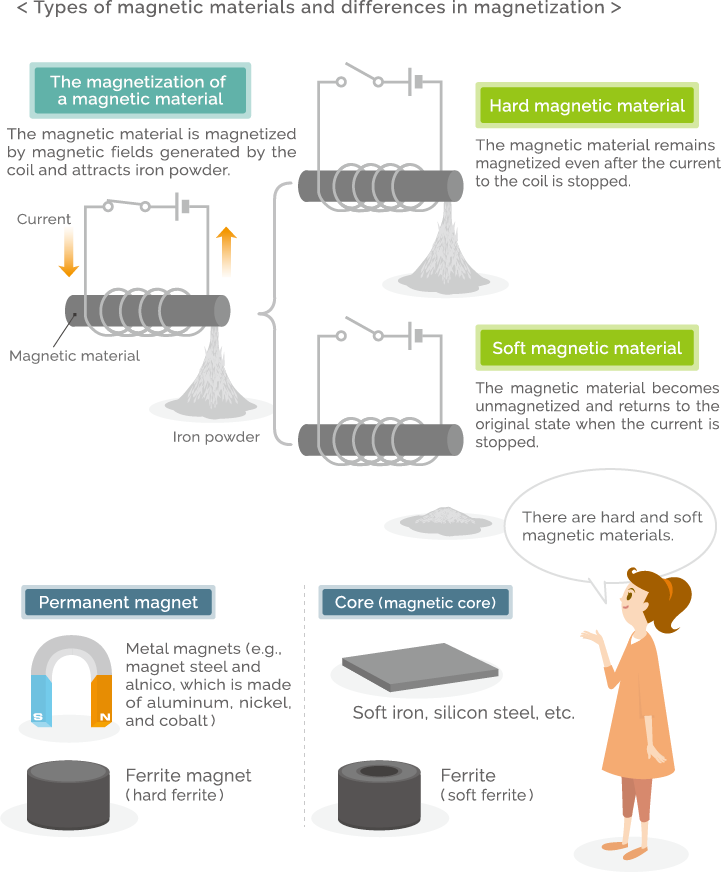
The electrical difference between metal magnetic materials (e.g., iron) and ferrite materials is their resistance values. While metal has low resistance and allows current to pass through it smoothly, ferrite has a high resistance and allows little current to pass through it. Ferrite is manufactured by molding and sintering powdery raw materials consisting primarily of iron oxide in the same way as for ceramic products. In other words, ferrite is a magnetic ceramic. China is used as insulators, and similarly, ferrite can be used as a suitable magnetic material for high-frequency equipment because it is a ceramic and therefore does not allow current to flow easily. For example, electromagnetic cooking devices and IH (induction heating) rice cookers use high-frequency current to heat a metal pot but have a heat generation problem (power loss) in the cores of high-frequency coils. Since ferrite is similar to an insulator material, it generates less heat and is suitable for the cores of coils (metal cores become red-hot before a pot is heated).
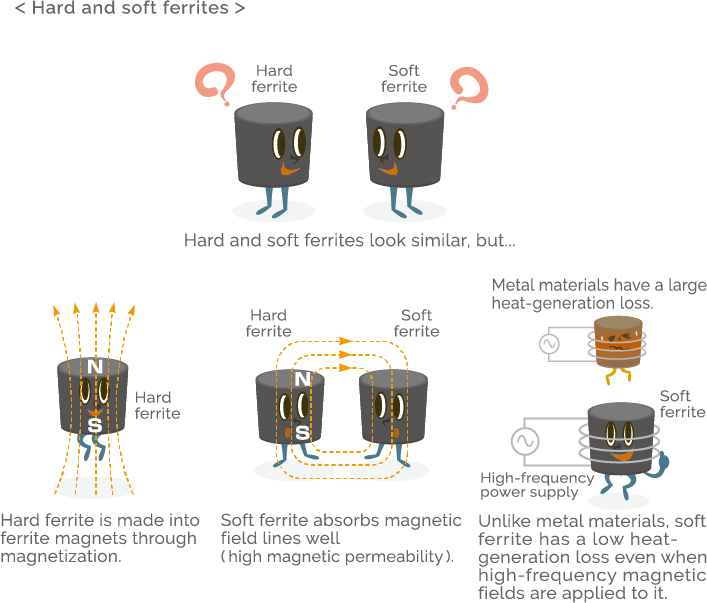
Ferrite is a material with unlimited potential
Probably, most people have never seen a manufacturing site for magnets. Hard ferrite is not originally a magnet. Hard ferrite right after the molding and sintering processes is simply a not-yet-magnetized material for magnets. It is finally made into ferrite magnets by applying strong magnetic fields generated from a coil. This is called magnetization. Soft ferrite only temporarily becomes a magnet and is not magnetized, but it is a magnetic material, so it, of course, sticks to a magnet.
So, why do magnetic materials such as iron and ferrite stick to magnets? Magnetic materials are substances in which many micro magnets face in different directions. If external magnetic fields (magnetic fields from a magnet or coil) are applied there, the micro magnets are aligned along the magnetic field lines (magnetization), and collectively behave as a magnet with N and S poles. If something is magnetized, it temporarily becomes a magnet. That is, magnets attract iron or ferrite fundamentally in the same manner as magnets attract each other.
When iron is heated to a certain temperature, it will finally cease to stick to a magnet. This temperature is called Curie temperature (Curie point), and the curie point for iron is about 800°C. Ferrite with variously different properties can be made by using a small amount of additive, etc., and its Curie temperature can be adjusted freely to some extent.
Ferrite ceases to stick to a magnet when it exceeds the Curie temperature, and this property means that it can function as a temperature sensor. This is called a temperature-sensitive ferrite. There is a temperature-sensitive reed switch, which consists of a permanent magnet hard ferrite, a temperature-sensitive soft ferrite, and a soft-iron reed switch. Currently, it is not often used, but it is a great example to understand two types of ferrite materials (hard and soft), Curie temperature, magnetic flux flow, etc. (Figure below)
Magnetic materials and curious properties of ferrite have so far been talked about as a prologue for this series, and their details will be provided later in this series. Some say that ferrite includes everything. This represents the interestingness and depth of the magnetic material called ferrite. Ferrite still has unlimited potential as if it was an inexhaustible spring.
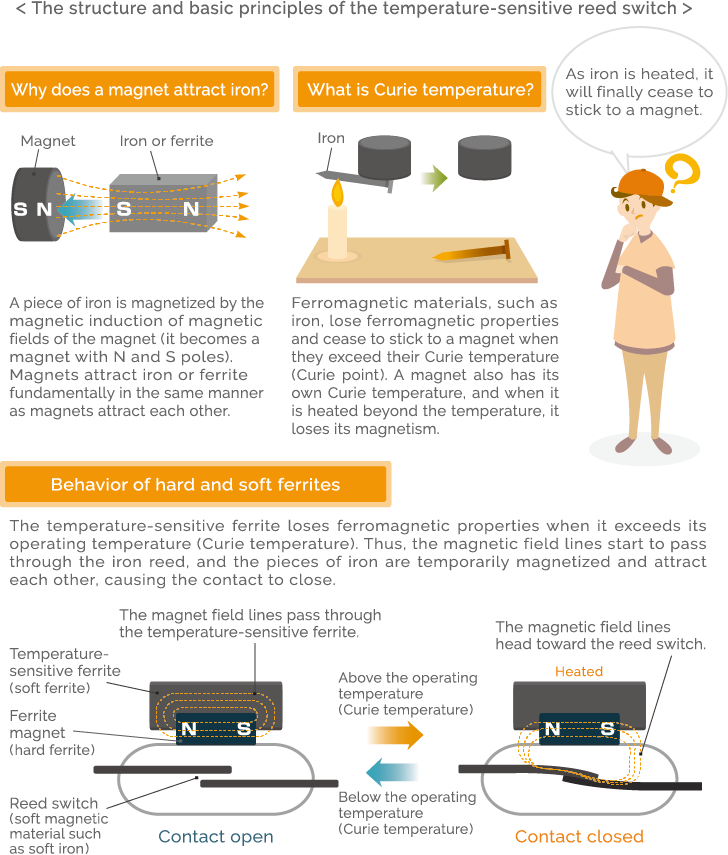
TDK is a comprehensive electronic components manufacturer leading the world in magnetic technology



